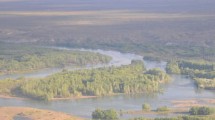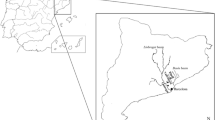Abstract
Several Prosopis species were introduced into South Africa in the last century. Since then two species, Prosopis glandulosa var. torreyana and Prosopis velutina have invaded large parts of arid southern Africa. Here, we examine the extent to which increased mortality of Acacia erioloba, a keystone species in the Kalahari Desert, can be attributed to competition for water with Prosopis. We do this for A. erioloba and Prosopis sp. at invaded, as well as cleared sites through a determination of species abundance, canopy vitality, plant water stress and plant water source. Our stable isotope results show that in the riparian zone both A. erioloba and Prosopis are using the same water source. Our results also show that there is a 50 % increase in canopy dieback of A. erioloba in the invaded river plots relative to the cleared river plots. This dieback cannot be related to changes in rainfall and temperature as there were no adverse fluctuations (drought) in the weather in the 10 years preceding our study. We speculate that because A. erioloba is more water stressed in the invaded river plot this increase in mortality and dieback is related to plant moisture stress that is not related to climate but to competition for water with Prosopis. Our study gives strong support for the eradication of Prosopis from rivers in arid parts of Southern Africa.






Similar content being viewed by others
References
ACITS (1997) Repeated measured ANOVA using SPSS Manova. University of Texas at Austin. http://www.utexas.edu/cc/docs/stat38.html. Accessed 12 Mar 2007
Bromilow C (2010) Problem plants and alien weeds of South Africa. Briza Publications, Pretoria
Brown JR, Archer S (1989) Woody plant invasion of grasslands: establishment of honey mesquite (Prosopis glandulosa var. glandulosa) on sites differing in herbaceous biomass and grazing history. Oecologia 80:19–26
Burkhart A (1976) A monograph of the genus Prosopis (Leguminoseae subfamily Mimisoideae). J Arnold Arbor 57:217–525
Busch DE, Ingraham NL, Smith SD (1992) Water uptake in woody riparian phreatophytes of the Southwestern United States: a stable isotope study. Ecol Appl 2(4):450–459
Canadell J, Jackson RB, Ehleringer JR, Mooney HA, Sala OE, Schulze ED (1996) Maximum rooting depth of vegetation types at the global scale. Oecologia 108:583–595
Coates PK, Coates PM (2002) Trees of southern Africa. Struik, Cape Town
Coleman ML, Shepherd TJ, Durham JJ, Rouse JE, Moore GR (1982) Reduction of water with zinc for hydrogen isotope analysis. Anal Chem 54:993–995
Craig H (1961) Isotopic variations in meteoric waters. Science 133:1702–1703
Ehleringer JR (1993) Variation in leaf carbon isotope discrimination in Encelia farinosa: implications for growth, competition, and drought survival. Oecologia 95:340–346
Ellsworth PZ, Williams DG (2007) Hydrogen isotope fractionation during water uptake by woody xerophytes. Plant Soil 291:93–107
February EC, Higgins SI, Newton R, West AG (2007a) Tree distribution on a steep environmental gradient in an arid savanna. J Biogeogr 34:270–278
February EC, West AG, Newton R (2007b) The relationship between rainfall, water source and growth for an endangered tree. Austral Ecol 32(4):397–402
Gile LH, Gibbens RP, Lenz JM (1997) The near-ubiquitous pedogenic world of mesquite roots in an arid basin floor. J Arid Environ 35:39–58
Harding GB (1987) The status of Prosopis as a weed. Appl Plant Sci 1(1):43–48
Jennings CMH (1974) The geohydrology of Botswana. PhD Thesis, University of Natal
Meyer R, Duvenhage AWA, de Beer JH, Huyssen RMJ (1985) A geophysicalgeohydrological study along the Kuruman River in the Kuruman and Gordonia districts. South Afr J Geol 88:501–515
Miller JM, Miller PC (1984) Leaf conductances and xylem pressure potentials in fynbos plants species. S Afr J Sci 80(88):381–385
Milton SJ, Dean WRJ (1995) How useful is the keystone species concept, and can it be applied to Acacia erioloba in the Kalahari Desert? Zeitschrift für Ökologie und Naturschutz 4:147–156
Mucina L, Rutherford MC (2006) The vegetation of South Africa, Lesotho and Swaziland. SANBI, Pretoria, pp 525–527
Mwangi E, Swallow B (2005) Invasion of Prosopis juliflora and local livelihoods: case study from the Lake Baringo area of Kenya. ICRAF working paper—no. 3. World Agroforestry Centre, Nairobi
Nilsen ET, Sharifi MR, Rundell PW (1991) Quantitative phenology of warm desert legumes: seasonal growth of six Prosopis species at the same time. J Arid Environ 20:299–311
Obakeng OT (2007) Soil moisture dynamics and evapotranspiration at the fringe of the Botswana Kalahari, with emphasis on deep rooting vegetation, PhD Dissertation, Dissertation No. 141, ITC, Enschede
Pockman WT, Sperry JS (2000) Vulnerability to xylem cavitation and the distribution of Sonoran desert vegetation. Am J Bot 87:1287–1299
Powell E (2005) What is happening to the camel thorns of Kathu? Veld and Flora, Cape Town, pp 34–35
Poynton RJ (1990) The genus Prosopis in southern Africa. S Afr For J 152:62–66
Robertson I, Woodborne S (2002) Carbon isotopes confirm the competitive advantages of Prosopis over Acacia erioloba. Study of environmental change using isotope techniques. International Atomic Energy Agency, Vienna IAEA-CSP-13/P
Sankaran M, Hanan NP, Scholes RJ et al (2005) Determinants of woody cover in African savannas. Nature 438(8):846–849
Sankaran M, Ratnam J, Hanan N (2008) Woody cover in African Savannas: the role of resources, fire and herbivory. Glob Ecol Biogeogr 17(2):236–245
Scholander PF, Hammel HT, Bradstreet ED, Hemmingsen EA (1965) Sap pressure in vascular plants. Science 148:339–346
Seibt U, Rajabi A, Griffiths H, Berry JA (2008) Carbon isotopes and water use efficiency: sense and sensitivity. Oecologia 155:441–454
Sekhwela and Yates (2007) A phenological study of dominant acacia tree species in areas with different rainfall regimes in the Kalahari of Botswana. J Arid Environ 70(1):1–17
Seymour CL, Huyser O (2008) Fire and the demography of camelthorn (Acacia erioloba Meyer) in the southern Kalahari—evidence for a bonfire effect? Afr J Ecol 46:594–601
Smit N (1999) Guide to the Acacias of South Africa. Briza, Pretoria
Socki RA, Karlsson HR, Gibson EK (1992) Extraction technique for the determination of Oxygen—18 in water using preevacuated glass vials. Anal Chem 64:829–831
Stromberg JC, Tress JA, Wilkins SD, Clark S (1992) Response of velvet mesquite to groundwater decline. J Arid Environ 23:45–58
Thomas DSG, Leason HC (2005) Dunefield activity response to climate variability in the southwest Kalahari. Geomorphology 64:117–132
van Auken OW (2000) Shrub invasion of North American semiarid grasslands. Ann Rev Ecol Syst 31:197–215
Van der Walt P, le Riche E (1999) The Kalahari and its plants. Published by authors, South Africa
Van Rooyen N, Bezuidenhout H, de Kock E (2001) Flowering plants of the Kalahari Dunes. Ekotrust, South Africa
Van Wilgen BW, Le Maitre DC, Cowling RM (1998) Ecosystem services, efficiency, sustainability and equity: South Africa’s working for water programme. Trends Ecol Evol 13:378
White JWC, Cook ER, Lawrence JR, Broecker WS (1985) The D/H ratios of sap in trees: implications for water sources and tree ring D/H ratios. Geochim Cosmochim Acta 49:237–246
Wise R, Van Wilgen BW, Le Maitre DC (2012) Costs, benefits and management options for an invasive alien tree species: the case of mesquite in the Northern Cape, South Africa. J Arid Environ 84:80–90
Zachariades C, Hoffman JH, Roberts AP (2011) Biological control of Mesquite (Prosopis species) (Fabaceae) in South Africa. Afr Entomol 19(2):402–415
Zimmermann HG (1991) Biological control of mesquite, Prosopis spp. (Fabaceae), in South Africa. Agric Ecosyst Environ 37(1–3):175–186
Acknowledgments
We would like to thank the National Research Foundation of South Africa for partial funding of this project. S. Davids and E. Zitha provided laboratory assistance. Prof. T. Clutton Brock’s team (especially T. Flower and A. Ross-Gillesby) of the Meerkat Project for access to the study site and their assistance in data collection. Mr. Masela of van Zylsrus gave us access to a borehole.
Author information
Authors and Affiliations
Corresponding author
Rights and permissions
About this article
Cite this article
Schachtschneider, K., February, E.C. Impact of Prosopis invasion on a keystone tree species in the Kalahari Desert. Plant Ecol 214, 597–605 (2013). https://doi.org/10.1007/s11258-013-0192-z
Received:
Accepted:
Published:
Issue Date:
DOI: https://doi.org/10.1007/s11258-013-0192-z




